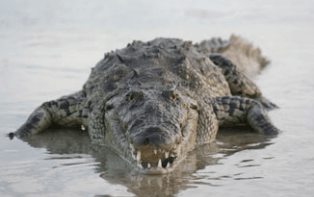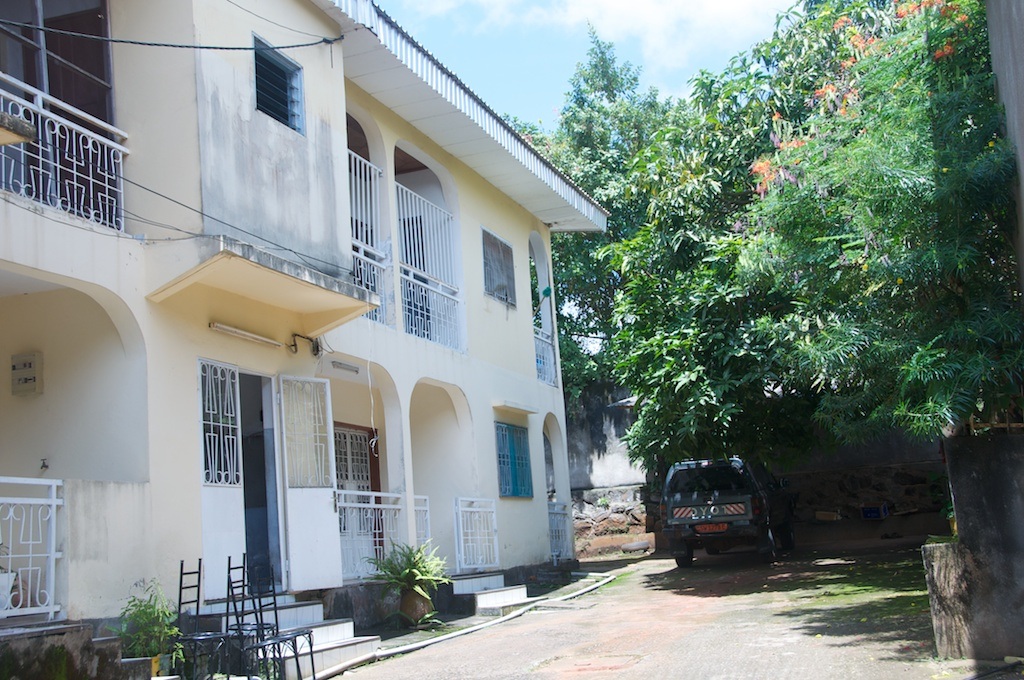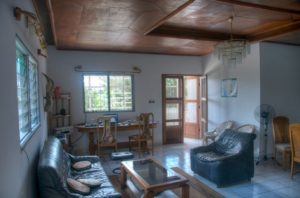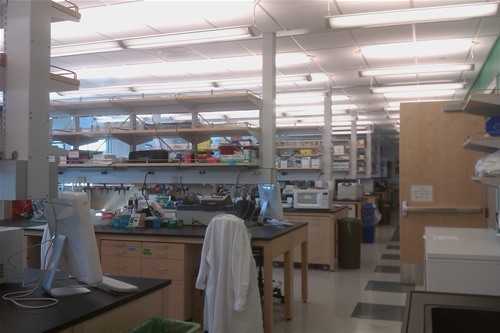
Center for Tropical Research November 2010 Newsletter
Letter from the Director
Dear Friends,
Our feature article in this Fall’s CTR Newsletter, by Adam Freedman, discusses CTR’s efforts to understand the implications of losing ecological gradients. While the impacts of habitat destruction and climate change are well known, and are on every conservation group’s radar screen, the loss of environmental gradients is not.
What are ecological gradients? The gradient described in the feature article occurs between the African savanna and rainforest, but gradients occur on every continent. For instance, our researchers are studying the gradient along the slope of the Andes in Ecuador. In this region, as you move from the lowlands to the highlands, populations of species change in both morphology and physiology. Populations at higher elevations are typically better adapted to colder temperatures than those at lower elevations.
Such gradients are also common in North America. They include the south-to-north transition from the eastern deciduous forests of the central United States to the boreal forests of northern Minnesota and Canada, and the elevational gradients in the Sierra Nevada mountains that extend from the Mohave Desert to the alpine environments of the Sierra’s crest.
Why are gradients important and what do we risk if we lose them? Essentially, the adaptive variation that is embodied in populations along gradients is like money in the bank as we struggle to address the impacts of climate change. By preserving gradients, one maximizes the amount of adaptive variation that is available. With the onslaught of climate change, scientists do not know what conditions to expect and how populations will respond. Given these uncertainties, the best strategy is to protect gradients, thereby preserving variation. Unfortunately, our recent research in Central and West Africa suggests gradients are disappearing and, as a consequence, populations are losing critical variation.
In the words of Aldo Leopold, the father of conservation biology, “To keep every cog and wheel is the first precaution of intelligent tinkering.” We need to get the message out that protecting environmental gradients is critical in the age of climate change.
Best Wishes,
Thomas B. Smith, Ph.D.
Feature Article
Flattening of the Rainforest-Savanna Gradient Reduces Adaptive Diversity in a Rainforest Bird in West Africa
by Adam Freedman, Ph.D., Postdoctoral Scholar, Ecology and Evolutionary Biology and Center for Tropical Research, Institute of the Environment and Sustainability, UCLA
Field Report
Identifying Stomach Parasitemia in Three New World Crocodilians
by Christina Marisa Tellez, Graduate Student, Ecology and Evolutionary Biology and Center for Tropical Research, Institute of the Environment and Sustainability, UCLA
Updates


CTR Establishes International Research and Training Center Facility in Cameroon
A UCLA International Research and Training Center (IRTC) for scholars doing research in Africa has been established in Cameroon. Sleeping accommodations, workspace, and free high-speed Internet access are available in a fully furnished apartment in the Bastos neighborhood of Yaoundé. The apartment has three bedrooms, two bathrooms, and a fully equipped kitchen. Since it has opened, researchers from Argentina, France, Senegal, South Africa, the United Kingdom, and the United States have stayed at the facility. The apartment serves as a resource center to coordinate projects throughout the region, provides researchers with logistical assistance, and enables scientists from different disciplines to collaborate on research projects.
For reservations, researchers should contact the facility manager, Tipa Julius, at tipaanyi@gmail.com, and copy Kevin Njabo, the CTR Africa Director, at kynjabo@ucla.edu. Enthusiastic support for the IRTC has been expressed by government agencies and university officials in the United States and Cameroon. Tom Smith has been meeting with foundations and individuals to raise funds for expansion of the IRTC. For more information, see the IRTC website at www.irtc.ucla.edu.
CTR Research Lab Moves to Terasaki Life Sciences Building


The Center for Tropical Research laboratory moved to the new Terasaki Life Sciences Building in September. We now share space on the 4th floor with the laboratories of Victoria Sork, Dean of Life Sciences, and Robert Wayne. With state-of-the-art facilities and an open floor plan, this new laboratory promises to foster greater interdisciplinary research and interaction between graduate students, postdoctoral researchers, and staff. Victoria Sork addressed hundreds of scientists and other members of the UCLA community at the October 25th grand opening of the new building.
UCLA Institute of the Environment and Sustainability (IoES) Announces Name Change
The UCLA Institute of the Environment (IoE) began the Fall 2010 quarter by announcing its new name, the UCLA Institute of the Environment and Sustainability (IoES). Explaining the name change, Institute Director Glen MacDonald said, “Adding this term reflects the rapidly increasing importance of sustainability science. It reflects the institute’s range of programs and our place as a major center of sustainability among national universities.” To read more on sustainability and the IoES, click here. As a center of the IoES, the CTR website and literature will reflect this name change.
CTR Graduate Students Receives Ph.D.
Ana Paula Giorgi received her Ph.D. from the UCLA Department of Geography in Summer 2010 for her thesis on “Spatial conservation planning framework for assessing conservation and restoration opportunities in the Atlantic Forest of Brazil.” She is beginning a new project entitled “Assessment analysis of priority areas for conservation and restoration under different climate scenarios based on avifauna occurrence data. The case of the Serra do Mar Biological Corridor.” The study is funded by the Nature Conservancy in collaboration with the UCLA Department of
CTR Welcomes New Researchers
Rachel Johnston joined the CTR research team in Fall 2010 as a new Ph.D. student in the UCLA Department of Ecology and Evolutionary Biology. Tom Smith and Robert Wayne will serve jointly as her thesis advisors.
Brenda Larison, a CTR Senior Research Fellow, joined the CTR avian influenza project in Spring 2010. She is part of the multi-country collaborative effort to examine spillover and transmission of avian influenza between wild and domestic birds.
CTR Affiliate Leaves UCLA for New Position
Victoria Arch completed her Ph.D. in the Department of Ecology & Evolutionary Biology in June 2010. She began a postdoctoral fellowship in the laboratory of Dr. Russell Fernald in the Department of Biology at Stanford University.
Video on Heron Island Summit
Tom Smith was a keynote speaker at the Applied Evolution Summit, “Interdisciplinary Solutions to Evolutionary Challenges in Food, Health and the Environment,” held on Heron Island, Australia, January 4-8, 2010. Click here to view the summit video, EvolutionIsland – Sustainable Solutions to Global Challenges.
CTR Researcher News
Chris Anderson began a postdoctoral fellowship at the Institute of Ecology at the Universidad Nacional Autónoma de México (UNAM) – Mexico City in Winter 2010 after receiving his Ph.D. in Spring 2009 from the UCLA Department of Ecology and Evolutionary Biology for his thesis entitled “Competitor recognition in Rubyspot Damselflies (Hetaerinaspp.).” He has continued working with CTR as a Senior Research Fellow and is visiting the UCLA Conservation Genetics Resource Center during Fall 2010 to build a microsatellite library for damselflies in the genus Paraphlebia.
Benoit Goossens, CTR Senior Research Fellow and Director of the Danau Girang Field Centre in Sabah, Malaysia, encourages CTR members to learn about the Centre’s activities from their website and to check out their September 2010 newsletter. This collaborative research and training facility, opened in July 2008, is located in the lowland rainforest of the Lower Kinabatangan Wildlife Sanctuary and is owned by the Sabah Wildlife Department and supported by Cardiff University.
Amy Rogers, a Senior Research Fellow at CTR and a former Ph.D. student in the UCLA Department of Ecology and Evolutionary Biology, gave an oral presentation entitled “Experimental evidence that dispersal limits succession in tropical secondary forest” at the annual Association for Tropical Biology and Conservation meeting held in Bali, Indonesia, in July 2010. Amy received the Luis F. Bacardi Advances in Tropical Conservation Award for her presentation. This award is presented annually to one young postdoctoral researcher in recognition of their outstanding conservation-related talk at the meeting. Amy is currently a Research Fellow at the Pinchot Institute for Conservation, and is based in Esmeraldas, Ecuador.
Field Research Trips
Allison Alvarado conducted field research in British Columbia, Canada, for five weeks in June and July 2010, where she traveled from islands off the coast to the Rocky Mountains. She recaptured five Hermit Thrushes that carried geolocator data loggers that she had attached to them last summer. Geolocators, which determine latitude and longitude through changes in light levels over space and time, weigh only one gram and can be used to track long-distance movements on very small animals. The data from the loggers will reveal details about the pattern and timing of migration for these passerines.
Emily Curd conducted eight weeks of soil sampling fieldwork in July and August 2010 for her dissertation project examining the determinants of soil microbial community assembly, specifically the role of carbon availability and soil pH (acidity or basicity) on community heterogeneity. She collected samples in 38 locations across four states: California, Oregon, Washington, and Nebraska.
Princess Gilbert traveled to Bali, Indonesia, in the summer of 2010 to work at the U.S. Agency for International Development-funded Indonesian Biodiversity Research Center, founded by Ecology and Evolutionary Biology Professor Paul Barber and collaborators from three Indonesian universities. In addition to participating in and assisting with courses on molecular genetics and biodiversity research, she conducted fieldwork using SCUBA to collect tissue samples for genetic analysis for components of her dissertation project on the evolution of Tetraodontiform fishes.
Rachel Johnston traveled to Ecuador’s Chocó rainforest for three weeks in July and August 2010. She visited the Bilsa Biological Research Station and worked with CTR Latin America Director Jordan Karubian, local biologists, and other students to study seed dispersal of Chapil Palms by Long-wattled Umbrellabirds. She also traveled to small communities in the Chocó rainforest to teach school children and speak with local residents about the benefits of conservation. In addition, she attended a two-day conference with biologists, government officials, and local stakeholders to discuss environmental issues.
Kevin Njabo and Tony Chasar are leading research teams in Cameroon during the Fall of 2010 to sample wild birds, domestic poultry, and swine as part of a multi-country collaborative effort to examine spillover and transmission of avian influenza. Tom Smith worked with them in Cameroon for ten days in October. The team led by Kevin Njabo, which includes Dennis Anye Ndeh, Eric Djomo Nana, Norbert Ngameni, Francis Alemanji Forzi, Abel Wade, and Laura Bessong, will survey eleven sites in the northern and central regions of the country between October 7 to December 17, targeting previous H5N1 outbreak areas wherever possible. They also plan to carry out observational studies and survey people to quantify the interactions between wild birds, domestic poultry, swine, and humans. Tony Chasar’s team, consisting of Claire Loiseau and Francis Alemanji Forzi (who will be joining the team for part of the time), will collect samples in the central and eastern regions of Cameroon. Tony Chasar and Claire Loiseau will then travel to the Republic of the Congo during November to carry out additional sampling – the first sampling for avian influenza in wild birds to be carried out there.
Hilton Oyamaguchi is spending November and December 2010 doing fieldwork in Brazil for his dissertation project. He will be collecting frogs and recording their calls along the gradient between the Amazon rainforest and the Brazilian savanna. Tom Smith traveled to Brazil for two weeks in November to join Hilton in the field.
Raul Sedano traveled to Colombia in September 2010 for three months for his third field season. He is studying evolutionary processes in Neotropical birds and investigating bird species distributions in the Northern Andes. In addition, he is using bioclimatic and paleoecological data to model spatial shifts in habitat suitability that will provide a historical baseline to evaluate how climate change is affecting species in the Andes. His research team obtained more than 1,200 samples of his target bird species during his previous field seasons.
Christina Marisa Tellez spent two months in Belize during Summer 2010 researching nematode stomach parasitism in the American and the Morelet’s Crocodile. The data from this research will be used by the Belize Forest Department to assess anthropogenic and environmental effects on crocodilian population stability, utilizing the nematodes as bioindicators of the stability of the environment. Additionally, the data will be used to understand the spatial ecology and parasitic behavior of nematodes between the American Alligator, American Crocodile, Morelet’s Crocodile, and the Spectacled Caiman.
Pamela Thompson spent the month of August 2010 in Careyes, Mexico, collecting fruit from Crescentia alata trees and germinating seedlings for later genetic analysis on pollen-mediated gene flow. She was assisted in the field by two undergraduates, one from the Universidad Nacional Autónoma de México (UNAM) and one from UCLA. She also traveled to Mexico City for one week to attend an orientation for the Fulbright award she received to study bat-mediated pollen dispersal in fragmented and continuous dry tropical forests along the coast of the state of Jalisco, Mexico, for nine months beginning in January 2011.
Awards, Presentations, and Appointments
Allison Alvarado received grants from Los Angeles Audubon and the Explorers Club to support her fieldwork in British Columbia, Canada, during Summer 2010. She was also awarded a Lida Scott Brown Research Grant and Fellowship from the Department of Ecology and Evolutionary Biology at UCLA.
Adam Freedman, Alison Hamilton, and Henri Thomassen gave presentations at the Evolution 2010 conference held June 25-29, 2010. This joint annual meeting of the Society for the Study of Evolution, the Society of Systematic Biologists, and the American Society of Naturalists was held in Portland, Oregon. Adam Freedman presented a paper entitled “Human impacts flatten rainforest-ecotone gradient and reduce adaptive diversity,” Alison Hamilton presented a paper on “Historical and environmental influences on intra-archipelago diversification in a south Pacific tree skink,” and Henri Thomassen presented a paper on “Mapping evolutionary process: conserving biodiversity in the face of climate change.”
Trevon Fuller and Tom Smith attended the National Science Foundation Migration Interest Group: Research Applied Toward Education (MIGRATE) Research Coordination Network meeting in Lake Constance, Germany, from June 19-23, where Tom Smith and Staffan Bensch, of Lund University, Sweden, led the Working Group, “The Role of Avian Migrants in Disease Transmission.”
Princess Gilbert received a National Institutes of Health Genomic Analysis and Training Program grant in the spring of 2010 to fund her Ph.D project on the evolution of Tetraodontiform fishes.
Ana Paula Giorgi gave a presentation at the 25th International Ornithological Congress held August 22-28, 2010 in Campos do Jordão, Brazil. The talk was entitled “Are existent protected areas effective for bird conservation? Analytical framework for assessing connectivity and restoration priorities in the Atlantic Forest of Brazil.” In addition, she was selected to be a participant in the Pan-American Advanced Studies Institute training workshop on “Expanding the Frontier in Tropical Ecology Through Embedded Sensors” sponsored by the Organization for Tropical Studies at La Selva Biological Station in Costa Rica.
Alison Hamilton presented a paper at the Joint Meeting of Ichthyologists and Herpetologists, held in Providence, Rhode Island from July 7-12, 2010 on “Morphological and molecular differentiation and evidence for adaptive diversification in a clade of lizards from Oceania.” In addition, she received a grant from the Systematics Research Fund of the Linnean Society of London and the Systematics Association for her project entitled “Combining morphological, genetic, and ecological variation to delimit and describe species in Pacific Island lizards.” She used the funding for a trip to the Smithsonian Museum of Natural History in September to examine specimens and to describe eight species of lizards new to science.
Kevin Njabo received a grant from the Rufford Small Grants Foundation for a research project to correlate vectors and diseases in the rainforests of Cameroon using molecular genetics and remote sensing. He is collaborating with Anton Cornel, a professor at University of California, Davis, on this project. Anton Cornel and one of his graduate students, Jenny Carlson, visited Cameroon in September 2010 to collect samples for the project.
Hilton Oyamaguchi received research grants from the UCLA Latin American Institute and the California Academy of Sciences Kristina Louie Memorial Fund in June 2010 to support his study of the mechanisms of diversification in South American frog populations along the gradient between the Amazon rainforest and the Brazilian savanna.
Christina Marisa Tellez received a Sigma Xi grant for her field season in 2010, as well as a National Science Foundation Graduate Research Fellowship for 2011-2013. She presented a poster at the 20th Working Meeting of the Crocodile Specialist Group, an international gathering held in Manaus, Brazil, from September 12-17. Her poster presentation was entitled “Investigations of host-parasite distributions of Alligator mississippiensisin Louisiana.”
Pamela Thompson received an Environmental Protection Agency Science to Achieve Results (EPA STAR) Graduate Fellowship for Fall 2010 to support her doctoral research on gene flow in a bat-pollinated tree found in tropical dry forests in Mexico. The award supports graduate students in environmental fields.
Grants
- National Science Foundation/National Institutes of Health/Fogarty International Center
Dynamics of Cross-species Influenza Transmission: An International Collaboration – Cameroon and Egypt. (2009-2011) - Disney Wildlife Conservation Fund
Long-distance Movements by Hornbills and the Conservation of Central African Rainforests. (2010-2011)
Donors
The Center for Tropical Research would like to thank Noah’s Naturals for their generous contribution in May 2010 through their participation in 1% for the Planet, a global movement of companies that donate 1% of their sales to a network of environmental organizations worldwide. Their donation is helping to fund the International Research and Training Center in Cameroon, Africa.
